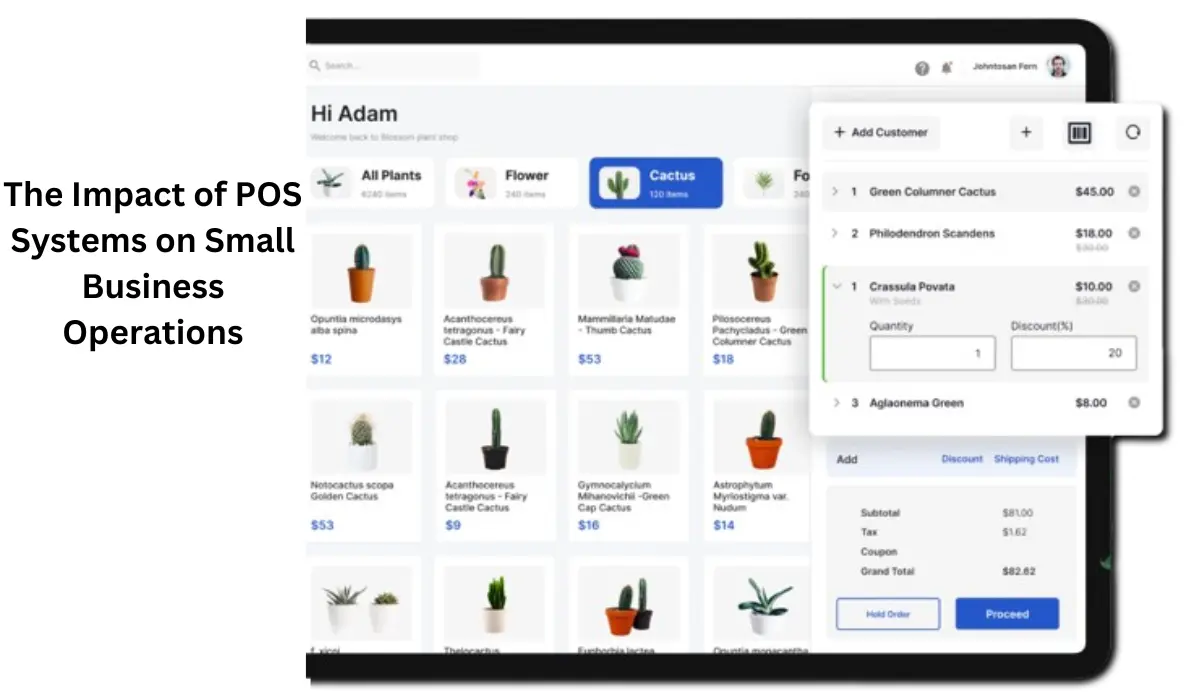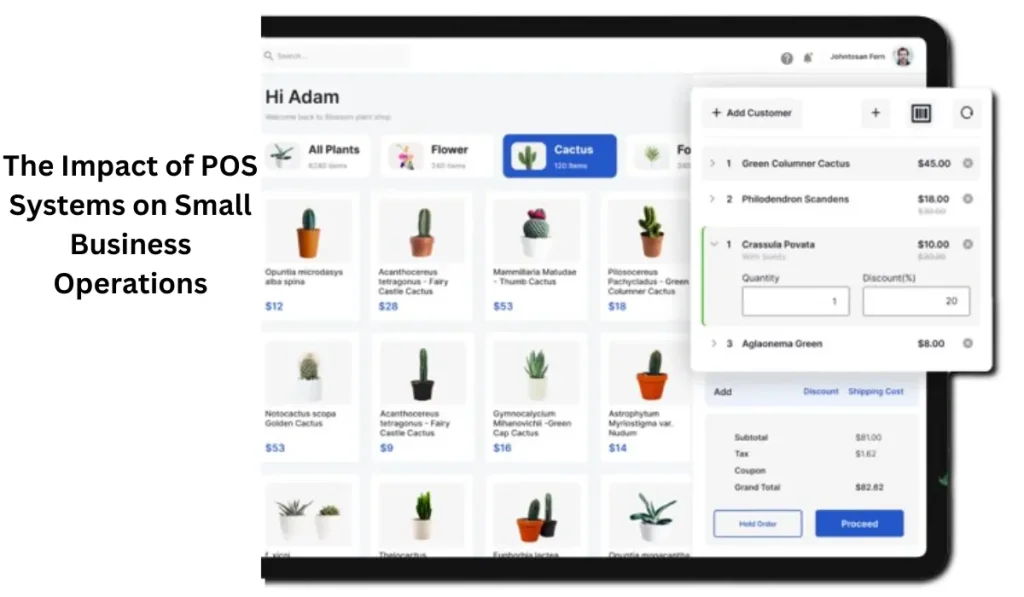The modern Point of Sale (POS) system has revolutionized how small businesses operate. Gone are the days of traditional cash registers and manual record-keeping. Today’s POS systems offer a suite of features that streamline operations, enhance customer experience, and provide valuable insights into business performance. This article explores the profound impact of POS systems on small business operations.
The Impact of POS Systems on Small Business Operations
The impact of POS systems on small business operations is transformative. By streamlining operations, enhancing customer experience, improving financial management, and offering adaptability and scalability, POS systems empower small businesses to operate more efficiently and compete more effectively in the marketplace.
Streamlined Operations
One of the most significant benefits of POS systems is the automation of various tasks, which streamlines business operations. Traditional cash registers required manual entry of sales, inventory checks, and end-of-day reconciliations. Modern POS systems, however, automate these processes, saving time and reducing human error.
Inventory Management: POS systems provide real-time tracking of inventory levels. Small business owners can set up automatic alerts for low stock, generate purchase orders, and even forecast demand based on historical sales data. This helps prevent stockouts and overstock situations, ensuring optimal inventory levels and reducing carrying costs.
Sales Reporting: Detailed sales reports are crucial for understanding business performance. POS systems generate comprehensive reports that include information on sales trends, peak business hours, and product performance. This data empowers business owners to make informed decisions, such as adjusting operating hours or promoting high-margin products.
Enhanced Customer Experience
In today’s competitive business landscape, providing an exceptional customer experience is crucial for the success of any small business. Modern Point of Sale (POS) systems are equipped with advanced features that streamline operations and significantly enhance the customer experience. This article delves into how these advanced POS features contribute to a superior customer experience.
Speed and Efficiency: Modern POS systems are designed for speed and ease of use. They allow for quick transactions, reducing wait times for customers. Features like barcode scanning and contactless payments further expedite the checkout process, making it more convenient for customers.
Personalization: POS systems can store customer data, including purchase history and preferences. This information can be used to personalize interactions, such as recommending products based on past purchases or offering targeted promotions. Personalized service makes customers feel valued and can increase their loyalty to the business.
Loyalty Programs: Many POS systems come with integrated loyalty program features. Small businesses can easily set up and manage loyalty programs that reward customers for their repeat business. Points, discounts, and special offers can be tracked and redeemed through the POS system, enhancing customer engagement and retention.
Financial Management and Reporting
Effective financial management is critical for the success of any small business. POS systems provide tools that simplify financial tracking and reporting, helping business owners maintain a clear picture of their financial health.
Accurate Financial Records: By automatically recording all sales transactions, POS systems ensure accurate financial records. This is crucial for bookkeeping, tax reporting, and financial analysis. Business owners can generate detailed financial reports, such as profit and loss statements, with just a few clicks.
Payment Processing: POS systems support various payment methods, including cash, credit/debit cards, and mobile payments. This flexibility caters to customer preferences and ensures smooth transactions. Additionally, POS systems can integrate with accounting software, simplifying the reconciliation of sales and payments.
Reduced Fraud and Theft: Advanced POS systems come with security features that help reduce the risk of fraud and theft. Features like employee access controls, audit trails, and real-time monitoring of transactions provide a layer of security that protects the business’s financial assets.
Adaptability and Scalability
As small businesses grow, their operational needs evolve. POS systems are highly adaptable and scalable, making them suitable for businesses of all sizes and types.
Multi-location Management: For small businesses expanding to multiple locations, POS systems offer centralized management capabilities. Business owners can monitor sales, inventory, and employee performance across all locations from a single dashboard. This centralized control simplifies management and ensures consistency across the business.
Integration with Other Systems: Modern POS systems can integrate with other business tools, such as e-commerce platforms, accounting software, and customer relationship management (CRM) systems. These integrations create a seamless flow of information, enhancing overall operational efficiency.
Scalable Solutions: Whether a business is a single-store operation or a growing chain, POS systems can scale to meet its needs. Small businesses can start with basic features and add more advanced functionalities as they grow, ensuring they always have the right tools to support their operations.
POS Systems in the Retail Industry: Trends and Innovations
The retail industry is undergoing a significant transformation driven by technological advancements, and Point of Sale (POS) systems are at the forefront of this evolution. Modern POS systems are not just cash registers but comprehensive tools that integrate various aspects of retail operations, enhancing efficiency and customer experience. This article explores the latest trends and innovations in POS systems within the retail sector.
1. Cloud-based POS Systems
Trend: The shift towards cloud-based POS systems is one of the most significant trends in the retail industry. These systems store data on remote servers, providing numerous advantages over traditional on-premises solutions.
Innovations:
Remote Access: Retailers can access their POS system from anywhere, allowing for real-time monitoring and management of sales, inventory, and customer data.
Automatic Updates: Cloud-based systems are updated automatically, ensuring that retailers always have access to the latest features and security enhancements.
Scalability: These systems can easily scale with business growth, accommodating additional stores or increased transaction volumes without significant infrastructure changes.
2. Mobile POS (mPOS)
Trend: The rise of mobile POS systems has revolutionized how retailers interact with customers, both in-store and in various retail environments such as pop-up shops and events.
Innovations:
Portability: mPOS systems, often run on tablets or smartphones, allow sales associates to process transactions anywhere in the store, reducing wait times and enhancing customer service.
Enhanced Customer Interaction: Sales staff can provide personalized assistance, check inventory, and make recommendations on the spot, improving the overall shopping experience.
Flexibility: mPOS systems are ideal for small retailers and businesses that operate in temporary or mobile settings, offering the flexibility to take payments wherever the customers are.
3. Integrated Omnichannel Solutions
Trend: Retailers are increasingly adopting omnichannel strategies to provide a seamless shopping experience across online and offline channels. POS systems are central to this integration.
Innovations:
Unified Inventory Management: Integrated POS systems synchronize inventory across all channels, ensuring consistent stock levels and reducing the risk of overselling.
Cross-channel Sales: Customers can buy online and pick up in-store (BOPIS), return online purchases in-store, and enjoy consistent promotions and loyalty benefits across all channels.
Customer Data Integration: By consolidating customer data from various touchpoints, retailers can deliver personalized experiences and targeted marketing campaigns.
4. Advanced Analytics and Reporting
Trend: Data-driven decision-making is becoming increasingly important in retail. Modern POS systems offer advanced analytics and reporting capabilities.
Innovations:
Real-time Insights: Retailers can access real-time sales data, track performance metrics, and monitor key indicators such as average transaction value and customer footfall.
Predictive Analytics: Advanced POS systems use machine learning algorithms to predict future sales trends, optimize inventory levels, and identify potential growth opportunities.
Customizable Reports: Retailers can generate detailed, customizable reports that provide insights into specific aspects of their business, aiding in strategic planning and operational efficiency.
5. Enhanced Payment Options
Trend: Offering a variety of payment options is essential for meeting customer expectations and improving the checkout experience.
Innovations:
Contactless Payments: With the growing popularity of contactless payments, POS systems are equipped to handle NFC-enabled cards and mobile wallets like Apple Pay and Google Pay.
Buy Now, Pay Later (BNPL): POS systems are integrating BNPL services, allowing customers to split their purchases into manageable installments, enhancing affordability and driving sales.
Cryptocurrency Payments: Some advanced POS systems are beginning to accept cryptocurrencies, catering to a niche but growing segment of tech-savvy customers.
6. AI and Machine Learning
Trend: Artificial intelligence (AI) and machine learning are being integrated into POS systems to enhance various aspects of retail operations.
Innovations:
Personalized Recommendations: AI algorithms analyze customer purchase history and preferences to provide personalized product recommendations, boosting sales and customer satisfaction.
Fraud Detection: Machine learning models can identify unusual transaction patterns and flag potential fraud in real-time, enhancing security.
Inventory Optimization: AI helps optimize inventory levels by predicting demand, reducing waste, and ensuring that popular items are always in stock.
7. Customer Relationship Management (CRM)
Trend: POS systems are increasingly incorporating CRM features to help retailers manage customer relationships more effectively.
Innovations:
Loyalty Programs: Integrated loyalty programs track customer purchases and reward them with points, discounts, or exclusive offers, fostering repeat business.
Customer Feedback: POS systems can prompt customers to provide feedback or reviews after their purchase, helping retailers gather valuable insights and improve service quality.
Personalized Marketing: Retailers can use CRM data to create personalized marketing campaigns, sending targeted offers and communications based on customer behavior and preferences.
8. Self-service Kiosks and Contactless Checkout
Trend: Self-service and contactless checkout options are becoming increasingly popular, driven by the demand for convenience and safety.
Innovations:
Self-service Kiosks: These kiosks allow customers to scan and pay for items independently, reducing wait times and freeing up staff to assist with other tasks.
Mobile Checkout: Customers can use their smartphones to scan items and complete the payment process, offering a completely contactless and hassle-free shopping experience.
Automated Stores: Some retailers are experimenting with fully automated stores where customers can enter, pick items, and leave without a traditional checkout process, with payments processed automatically via mobile apps or RFID technology.
Success Stories: Small Businesses Leveraging POS Systems for Growth
Point of Sale (POS) systems have proven to be transformative tools for small businesses, enabling them to streamline operations, improve customer service, and drive growth. This article highlights several success stories of small businesses that have effectively leveraged POS systems to achieve remarkable growth and operational efficiency.
1. The Coffee Beanery: Streamlining Operations and Enhancing Customer Experience
Background: The Coffee Beanery, a small local coffee shop, was struggling with long wait times and inefficient inventory management.
Solution: The owners implemented a cloud-based POS system that integrated inventory management, customer loyalty programs, and real-time sales reporting.
Impact:
Reduced Wait Times: The new POS system allowed for faster transaction processing, reducing wait times and improving customer satisfaction.
Inventory Management: Real-time inventory tracking helped the owners keep popular items in stock, reducing lost sales due to stockouts.
Loyalty Programs: The integrated loyalty program encouraged repeat business, increasing customer retention and sales.
Growth: Within a year, The Coffee Beanery saw a 20% increase in sales and expanded to a second location, thanks to the efficiencies gained from the POS system.
Also Read
2. The Little Bookshop: Expanding Online and In-store Sales
Background: The Little Bookshop, an independent bookstore, wanted to expand its sales channels by launching an e-commerce site but lacked the necessary technology to integrate online and offline sales.
Solution: They adopted an omnichannel POS system that seamlessly integrated with their new e-commerce platform.
Impact:
Unified Inventory: The POS system provided a unified view of inventory, ensuring accurate stock levels across both online and in-store channels.
Customer Experience: Customers enjoyed a seamless shopping experience, with options for in-store pickup of online orders and easy returns.
Sales Growth: The addition of an online sales channel contributed to a 30% increase in overall sales within the first six months.
Operational Efficiency: The automated inventory management and sales reporting freed up time for staff to focus on customer service and community events, further enhancing customer loyalty.
3. Baker’s Delight: Optimizing Business Operations with Mobile POS
Background: Baker’s Delight, a small bakery, faced challenges with long lines during peak hours and difficulties in managing special orders and deliveries.
Solution: The bakery implemented a mobile POS system that allowed sales associates to take orders and process payments anywhere in the store.
Impact:
Reduced Lines: The mobile POS system reduced congestion at the checkout counter, speeding up the transaction process during busy times.
Special Orders: Customers could place special orders and schedule deliveries more efficiently, improving service quality and customer satisfaction.
Increased Sales: With improved customer flow and service, Baker’s Delight saw a 15% increase in sales and expanded its delivery service area.
Enhanced Customer Experience: The ability to provide personalized service and quicker checkouts led to higher customer satisfaction and repeat business.
4. Urban Outfitters: Leveraging Data for Strategic Decisions
Background: Urban Outfitters, a boutique clothing store, needed better insights into customer behavior and sales trends to make informed business decisions.
Solution: The store adopted a POS system with advanced analytics and reporting capabilities.
Impact:
Sales Insights: Detailed sales reports helped identify best-selling products, peak sales periods, and customer preferences.
Inventory Optimization: Data-driven inventory management reduced excess stock and improved turnover rates, freeing up capital and space for new merchandise.
Targeted Marketing: The store used customer data to create targeted marketing campaigns, increasing the effectiveness of promotions and driving sales.
Strategic Growth: With actionable insights, Urban Outfitters opened a second location in a high-demand area, resulting in a 25% increase in overall revenue.
5. Gourmet Grocer: Enhancing Loyalty and Expanding Customer Base
Background: Gourmet Grocer, a small specialty food store, wanted to enhance customer loyalty and attract new customers.
Solution: They implemented a POS system with integrated CRM and loyalty program features.
Impact:
Customer Loyalty: The loyalty program rewarded repeat customers with points and exclusive discounts, increasing customer retention.
Personalized Marketing: The CRM features allowed for personalized email campaigns and special offers, tailored to individual customer preferences.
New Customer Acquisition: Targeted promotions and referral incentives attracted new customers, expanding the store’s customer base.
Revenue Growth: As a result of improved customer loyalty and targeted marketing, Gourmet Grocer saw a 20% increase in revenue and expanded its product range to meet customer demand.
Conclusion
As technology continues to evolve, the capabilities of POS systems will only expand, offering even greater benefits to small business owners. Investing in a modern POS system is not just a smart decision; it is essential for any small business looking to thrive in today’s competitive environment





